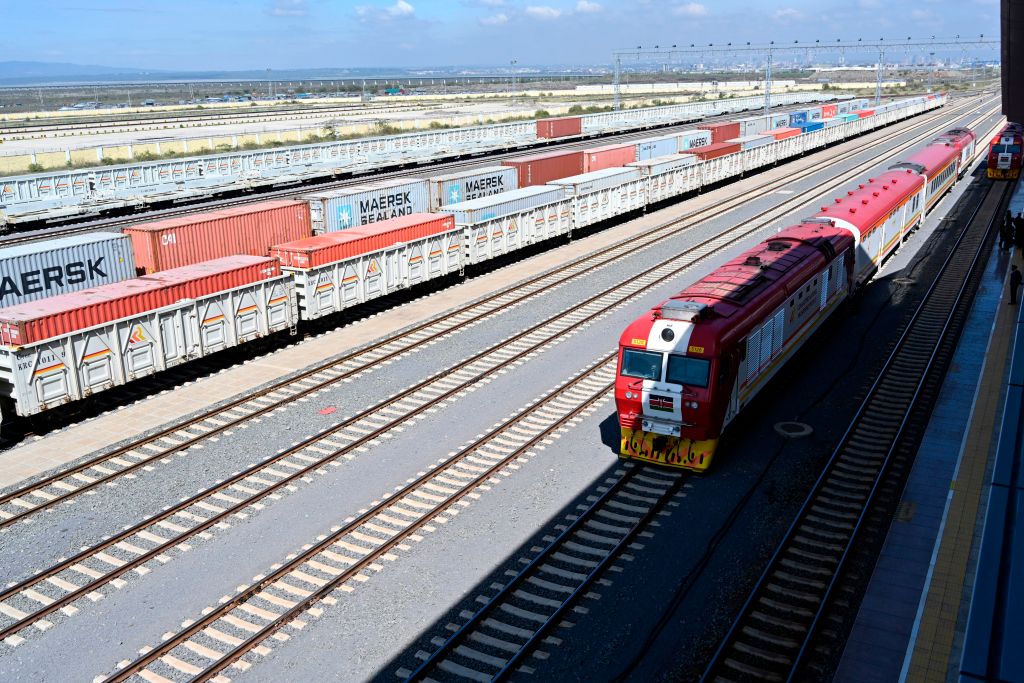ADF STAFF
Kenya’s Chinese-built Standard Gauge Railway (SGR) was supposed to be an economic engine for East Africa, linking the middle of the continent to the port at Mombasa. Instead, the SGR has become a financial burden that consumes an ever-increasing chunk of the nation’s revenue.
Although passengers praise the 480-kilometer railway, the SGR’s lifeblood is supposed to be cargo. In that regard it has failed to live up to expectations since it opened in 2017.
- Construction stopped far short of Uganda when repayment concerns caused Chinese lenders to throttle SGR financing. The railway now ends near Naivasha, more than 300 kilometers from the Ugandan border. Uganda pulled out of the SGR project, opting to use a Turkish company to develop its end of the rail line.
- The SGR is more expensive for shipping companies compared to truck transportation from Mombasa. A now-ended policy forcing shippers to use the SGR drove up shipping costs by nearly 30%, according to a study by researchers at the University of Nairobi.
- The railway’s $4.7 billion price tag helped drive up Kenya’s debt over the past decade, pushing it from 38% of gross domestic product (GDP) in 2012 to nearly 70% this year, according to the Central Bank of Kenya.
In July 2023, Kenya’s semiannual SGR debt payment to China reached $356 million, making up nearly 80% of that month’s $451 million debt payout, the government reported.
Kenya’s ballooning debt to China now sits at $6 billion with some of the loans coming due over the next 12 months. Many of China’s loans to Kenya and other African countries are “non-concession” loans through institutions such as the China ExIm Bank. Because of this, they can’t be forgiven. Rather, the loans often are renegotiated in a way that extends their terms and payments well beyond their original deadlines.
Even as his country is struggling to repay what it owes China, President William Ruto was in Beijing in October to request another $1 billion in loans. Deputy President Rigathi Gachagua told a local radio station that Ruto asked Chinese officials to slow the repayment of Kenya’s existing loans, while also borrowing money to finish stalled road projects.
Those stalled projects could include completing the final leg of the railroad from Naivasha to the Uganda border.
“The Kenya SGR desperately needs cross-border expansion to make it a financially sustainable project. This is another key element in Kenya’s negotiation,” economist Aly Khan Satchu told The Associated Press.
In recent years, China has cut back on the amount of lending it does in Africa as borrower countries confront potentially crippling levels of debt that threaten to destabilize their economies.
Until the SGR extends its reach and expands its operations, it seems likely to remain a financial burden on the government.
The Chinese-funded feasibility study that underpinned the project claimed the railway would be profitable by moving 22 million tons of freight a year, or 20 trains a day every day — more than double the line’s actual operating capacity, according to a study by the Kenya Institute for Public Policy Research and Analysis.
In 2018, the SGR operated eight freight runs a day carrying 108 cargo containers double stacked. By 2021, a sharp drop in cargo forced the railway to end the double-stacking policy and cut its daily runs from eight trains to five, according to the International Railway Journal. That change also raised more questions about Kenya’s ability to pay off the railway’s debt.
In 2023, the Kenya Railway Corp. reported an average of 18 to 20 trains a day between Mombasa and transit hubs in Nairobi and Naivasha. Kenyan authorities reported that the SGR’s income reached $84 million in 2022, up 4% over the previous year.
Even as it grows, the SGR’s income remains far below the amount needed to repay its debt. Nevertheless, many Kenyan officials support expanding the railway — somehow.
“It will be more productive for us to continue with the project,” Kenya’s Transport Cabinet Secretary Kipchumba Murkomen told the BBC. “But the financing part is actually our challenge.”

